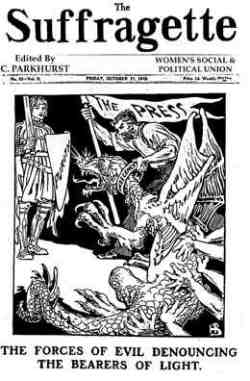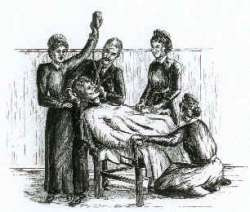|
In February 1914 Ethel
Moorhead became the first suffragette to be force fed in Scotland. Force
feeding, whilst it could never be described as fun, was particularly brutal
in Perth Prison where rectal feeding was forced on some suffragettes.
Fortunately for Ethel,
she was confined in Calton Jail in Edinburgh and was released with nothing
more severe than double pneumonia – the result of food getting into her
lungs whilst being forcibly fed.
Ethel had previously
been arrested and was released under the notorious Cat and Mouse Act. This
cunning piece of legislation, officially called the Prisoner's Temporary
Discharge of Ill Health Act meant that suffragettes were allowed to go on
hunger strike but as soon as they became ill they were released. Once they
recovered, the police re-arrested them and returned them to prison where
they continued their sentences until they became ill and were released
again, or completed it.
But as the authorities
were to learn, Ethel was not easily intimidated and something as trivial as
“parole” didn't stop her reconnoitering Traquair House, for a wee bit of
arson the authorities presumed, and banged her up again.
 |
| The
Suffragette - the WPSU newsletter |
|
Ethel was born in the
1870's, the daughter of an army surgeon. The family were moderately
well-to-do and Ethel spent some time studying painting in Paris and was
regarded as talented enough to have several exhibitions.
Her involvement in the
suffragette movement began in 1910 when she joined the Women's Social and
Political Union (WSPU), the militant movement formed by Emmeline and
Christabel Pankhurst in 1903. Her first recorded acts of dissent were in
1911 when she threw an egg at Winston Churchill at a political meeting in
Dundee and then became Dundee's first tax resister (refusing to pay tax on
the basis of “no taxation without representation”).
In 1912 she was charged
with smashing the windows of Thomas Cook's but was acquitted on the grounds
of insufficient evidence. It didn't deter her. She broke a glass case at the
Wallace Monument in Stirling in the autumn of 1912. The act was deliberately
designed to invoke the symbolism of the struggle for freedom. This cost her
a night in Stirling Jail and she also spent a week in Perth Prison later in
the same year. Neither experience broke her spirit with one prison governor
describing her as “insolent and defiant”.
By December of 1912,
Ethel was obviously getting a taste for adventure. She threw a stone at a
car she thought was carrying Lloyd George, the Chancellor of the Exchequer
of the day. It missed but the police didn't miss Ethel and she was banged up
again. Once inside she smashed several panes of glass in her cell windows,
refused to leave the exercise yard and went on hunger strike.
In January of 1913, she
was arrested again, this time in Cupar, Fife. The offence? She threw pepper
into the face of a policeman. True to form she smashed the glass in the
police cell, flooded the passageways of the prison by turning on all the
water in the lavatories and chucked a bucket of water on the prison officers
who came to subdue her.
By the autumn of 1913,
suffragette tactics had become more radical and involved fire-raising. Ethel
was arrested in Glasgow in possession of fire-lighting equipment. She was
sentenced to eight months imprisonment. Predictably defiant, Ethel was
removed from the court during proceedings for contempt.
She immediately went on
hunger strike and was released under the Cat and Mouse Act and instructed to
report back to prison in 7 days. She didn't.
She was on the run for
several months during which time police attributed at least four arson
attacks to her.
 |
| Force
feeding was brutal and caused public outrage
|
|
Presumably they would
have ascribed a fifth if she hadn't been spotted and arrested at Traquair
House. This time though there was no Cat and Mouse Act release and she was
force fed, causing the double pneumonia.
She was released again
with instructions to return to prison to complete her sentence. Guess what
.... she went on the run again.
It would take until 1918
for women to achieve suffrage and even then only for women over the age of
30. With women of the character of Ethel as opponents, FirstFoot is
astonished the authorities didn't give up after six months. They were never
going to win.
|